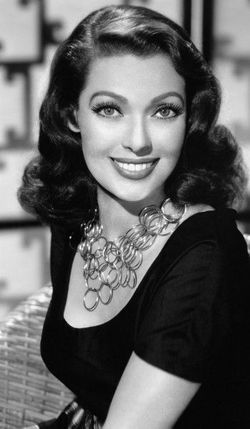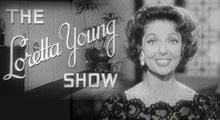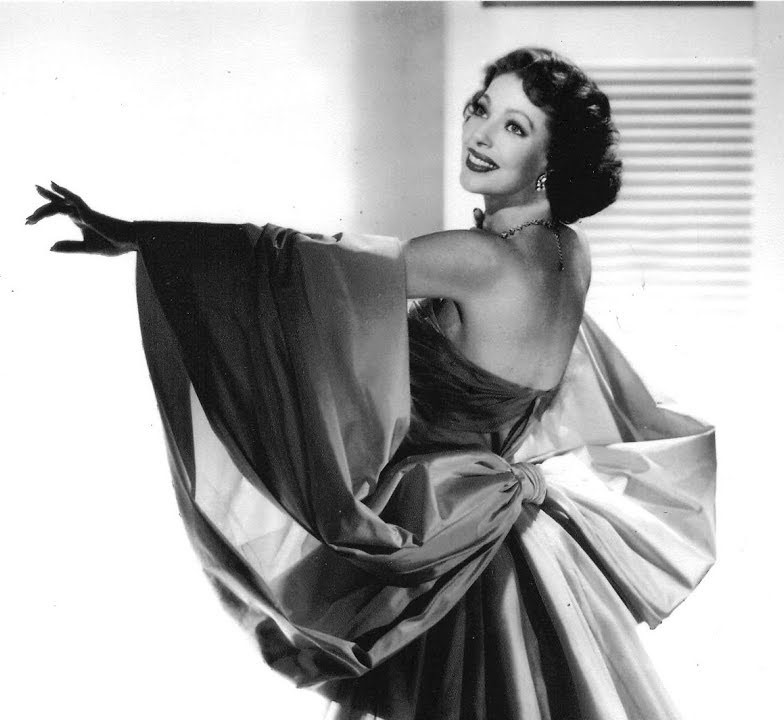Our previous post on Loretta Young (1913-2000) was beyond cursory. Written in 2014 when my main focus for new posts was silent film, I wrote (and with substantial brevity) about a single film, the moody Goth romp Laugh Clown Laugh (1928) with Lon Chaney. Young was only 14 at the time and yet cast as the romantic lead (though that was pretty common at the time). But that’s nothing; Young had been in movies since she was three years old. Throughout the silent era and the early talkies, she was cast mainly in bit parts. Born Gretchen Young, she was one of three performing sisters, the others being Polly Ann Young (1908-1997) and Elizabeth Jane Young (1910-1997) better known as Sally Blane. A later half-sister Georgiana Young (1924-2007) was married to Ricardo Montalban.
In 1930 Loretta became a WAMPAS Baby Star and this began to raise her profile. She started out starring in Pre-Code melodramas, things like They Call It Sin (1932), Employees Entrance (1933) and Born to be Bad (1934) when she was not yet 20. Other of her significant pictures include The Call of the Wild (1934), The Crusades (1935), Ramona (1936), Suez (1938), The Story of Alexander Graham Bell (1939), Along Came Jones (1945), The Stranger (1946), The Farmer’s Daughter (1947 ) and Rachel and the Stranger (1948). The Farmer’s Daughter won her an Oscar for playing a comical Swede; the film was later turned into a sitcom starring Inger Stevens (Young herself was of Luxembourgish extraction. It happens. Vincert Kartheiser, Pete Campbell of Mad Men, is of similar background).
In 1953 Young moved over from movies to television, a savvy and well-calculated move, because her prestige in films had been waning — and she made a smash in TV. The Loretta Young Show was on the air from 1953 through 1961, making it a long-term staple of that classic era of television. The show changed format a few times. For most of its existence it was a dramatic anthology series not unlike Robert Montgomery Presents. Young introduced some of the episodes as hostess; she personally acted in others. Originally the show was known as Letter to Loretta, and the premise was that the stories were based on real letters that she had received from fans. Her trademark was a big sweep of her gown as she turned from the narration to the story, much imitated by comedians.
Naturally top Hollywood stars guested on the show, and episodes were directed by the likes of Robert Florey, Norman Foster (her brother-in-law), and Richard Donner. In 1962 she switched format drastically, changing to a sit-com (a move about as radical as some of the shifts on the latter Doris Day Show). Here she seemed to want to emulate The Donna Reed Show; she played a suburban mom trying to raise seven children — two of whom were Dirk and Dack Rambo! This show lasted only one season, after which she essentially retired from acting. She later returned to star in a couple of TV movies, Christmas Eve (1986, with Arthur Hill), and Lady in the Corner (1989) with Brian Keith.
The Young sisters were all beautiful and resembled one another, sharing the same sort of toothy loveliness, but Gretchen (Loretta) scored the biggest career, followed by Sally Blane, who had a large number of movie credits and married the director Norman Foster, as we said. Polly Anne’s 40 credits stop with Invisible Ghost (1941). Georgiana had all of three bit parts.
It’s safe to say that Young was improperly sexualized at a premature age. In addition to playing roles too old for her, she married actor Grant Withers when she was just 17, although that only lasted a few months. The most extraordinary (and now well documented) bit of spice in her biography is that in the ’30s she was raped (by her own account) by MGM co-star Clark Gable, resulting in the child Judy Lewis, whom Young publicly claimed was adopted. Lewis was to become a successful actress and producer of daytime soaps. Her enormous blue eyes resembled both of her birth parents, however, and this “secret” was the source of much conjecture back in the day. Young was a Conservative Catholic, with a “wholesome” image quite at odds with a birth-out-of-wedlock story, despite the fact it wasn’t her fault. The irony is that her early talking films were frequently all about such scenarios. But then, pop culture has always been about amnesia as much as nostalgia.




[…] On Loretta Young and Her Sisters […]
LikeLike